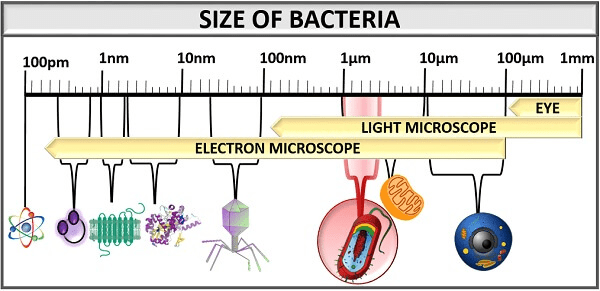Bacteria‐Size- Bacteria come in various sizes, but they are typically quite small compared to eukaryotic cells (cells with a true nucleus). The size of bacteria can vary depending on the species, but here are some general guidelines:
- Cocci (Spherical Bacteria):
- Diameter: Cocci can range in size from about 0.5 to 2.0 micrometers (µm).
- Bacilli (Rod-Shaped Bacteria):
- Length: Bacilli are typically between 1.0 and 5.0 µm long.
- Diameter: Their diameter is usually around 0.5 to 1.0 µm.
- Spiral and Curved Bacteria:
- Spiral and curved bacteria can vary in size, but they are generally similar in size to cocci and bacilli.
It’s important to note that these are general size ranges, and there can be exceptions. Some bacteria are exceptionally tiny and fall below these size ranges, while others can be larger, especially if they form multicellular structures or filaments.
Bacteria are measured in micrometers (µm), which are one-millionth of a meter. This small size allows them to exist virtually everywhere on Earth, from the deepest ocean trenches to the highest mountain peaks, and they play crucial roles in various ecosystems and in the fields of microbiology and biotechnology.
What is Bacteria‐Size
Bacteria vary in size, but they are typically quite small microorganisms. Their size is generally measured in micrometers (µm), which are one-millionth of a meter. Here are some general size ranges for bacteria:
- Cocci (Spherical Bacteria):
- Diameter: Typically between 0.5 to 2.0 micrometers (µm).
- Bacilli (Rod-Shaped Bacteria):
- Length: Usually ranging from 1.0 to 5.0 micrometers (µm).
- Diameter: Typically around 0.5 to 1.0 micrometers (µm).
- Spiral and Curved Bacteria:
- These bacteria can vary in size but are generally similar in size to cocci and bacilli.
Keep in mind that these are general size ranges, and there can be variations within bacterial species. Some bacteria are exceptionally small, falling below these size ranges, while others can be larger, especially if they form multicellular structures or colonies. Understanding the size of bacteria is important in microbiology, as it helps scientists classify and study different bacterial species.
Who is Required Bacteria‐Size
The size of bacteria is essential in various fields of science and research, including microbiology, biotechnology, and medicine. Here are some reasons why knowing the size of bacteria is required or important:
- Microbiology: Understanding the size of bacteria is fundamental in microbiology because it helps scientists and researchers classify and identify different bacterial species. The size, shape, and arrangement of bacterial cells are key characteristics used for taxonomic classification.
- Medical Diagnosis: In clinical microbiology, knowing the size and morphology of bacteria is crucial for diagnosing infections. It helps medical professionals identify the causative agents of diseases and choose appropriate treatments.
- Biotechnology: In biotechnology, bacteria are often used as host organisms for genetic engineering and the production of various bioproducts, such as pharmaceuticals, enzymes, and biofuels. Understanding their size is important for engineering and optimizing their growth and productivity.
- Environmental Science: Studying the size and abundance of bacteria in environmental samples, such as soil, water, and air, is important for understanding microbial ecology, nutrient cycling, and environmental health.
- Nanotechnology: Bacteria are sometimes used as templates for the fabrication of nanoscale materials and structures. Understanding their size and shape is critical for these applications.
- Food Industry: Bacteria play essential roles in food production, preservation, and fermentation. Knowledge of bacterial size is important for controlling and optimizing these processes.
- Antibiotic Development: Understanding the size and structure of bacteria is crucial for the development of antibiotics and antimicrobial agents.
- Biological Research: Bacteria are used as model organisms in biological research to investigate various cellular processes. Knowledge of their size helps researchers design experiments and interpret results.
In summary, the size of bacteria is required in various scientific and practical applications, ranging from basic research to medical diagnosis and industrial processes. It forms the basis for understanding bacterial morphology, taxonomy, and function, and it is vital for advancing knowledge and applications in these fields.
When is Required Bacteria‐Size

The size of bacteria is required or becomes important in various situations and applications. Here are some specific instances when knowledge of bacterial size is crucial:
- Microbiological Identification: When scientists and microbiologists are trying to identify and classify bacterial species, one of the key characteristics they consider is the size and shape of the bacterial cells. This information is essential for taxonomic purposes.
- Clinical Diagnosis: In the field of medicine, knowing the size and morphology of bacteria is critical for diagnosing infections. Identifying the specific bacteria causing an illness can guide treatment decisions.
- Pharmaceutical Development: In the development of antibiotics and other pharmaceuticals that target bacteria, understanding bacterial size and structure is vital. This knowledge helps researchers design drugs that can effectively interact with and disrupt bacterial cells.
- Biotechnology and Genetic Engineering: When scientists work with bacteria in biotechnological applications, such as genetically engineering bacteria for the production of proteins or biofuels, they need to consider bacterial size and growth characteristics to optimize production processes.
- Environmental Microbiology: In environmental science and ecology, understanding the size and abundance of bacteria in various ecosystems is essential for studying nutrient cycling, microbial communities, and the overall health of ecosystems.
- Nanotechnology: Bacteria are sometimes used as templates for creating nanoscale structures and materials. Precise knowledge of bacterial size and morphology is required for these nanotechnology applications.
- Food Industry: Bacteria are widely used in food production and preservation processes. Knowledge of bacterial size is important for controlling fermentation, ensuring food safety, and optimizing production methods.
- Biological Research: Bacteria are used as model organisms in biological research to study cellular processes and mechanisms. In these studies, understanding bacterial size is crucial for experimental design and data interpretation.
In essence, the required knowledge of bacterial size arises whenever bacteria are involved in scientific research, medical diagnostics, industrial processes, or other applications. It serves as a foundational aspect of understanding bacteria’s morphology, physiology, and behavior in different contexts.
Where is Required Bacteria‐Size
The requirement for knowledge about the size of bacteria can be found in various fields and situations. Here are some specific contexts where understanding bacterial size is necessary:
- Microbiology Laboratories: In microbiology labs, scientists and researchers routinely examine bacterial cultures under microscopes to identify and classify bacterial species. Knowledge of bacterial size is essential for accurately characterizing and differentiating between various types of bacteria.
- Clinical Settings: Healthcare professionals, particularly clinical microbiologists and medical laboratory technicians, need to determine the size and shape of bacteria when diagnosing infections. This information helps identify the causative agents of diseases, which is crucial for selecting appropriate treatments.
- Pharmaceutical and Biotechnology Industries: Companies and research institutions involved in drug development, biotechnology, and genetic engineering rely on an understanding of bacterial size when working with bacteria for various purposes. This includes optimizing fermentation processes, designing drug delivery systems, and engineering bacteria for bioproducts.
- Environmental Research: Environmental scientists and ecologists studying microbial communities in soil, water, and other ecosystems need to know the size and abundance of bacteria. This knowledge is vital for assessing environmental health, nutrient cycling, and the roles bacteria play in ecosystems.
- Nanotechnology Labs: Bacteria are sometimes used as templates or scaffolds in nanotechnology research to create nanoscale structures. Precise knowledge of bacterial size is crucial in these applications to control the dimensions of the resulting nanomaterials.
- Food and Beverage Industry: Bacteria are used in food production, preservation, and fermentation processes. Understanding bacterial size and growth characteristics is essential for ensuring the safety and quality of food products.
- Academic Research: Bacterial size is a fundamental aspect of biological research. Researchers studying cellular processes, genetics, and physiology often work with bacteria as model organisms. Knowledge of bacterial size is integral to designing experiments and interpreting results.
- Biological Education: In educational settings, instructors and students in microbiology and related fields teach and learn about bacterial size to understand basic microbiological concepts and techniques.
In summary, knowledge of bacterial size is required in a wide range of settings and disciplines, including laboratories, clinical settings, industries, research institutions, and educational environments. It forms the basis for various scientific, medical, and industrial applications involving bacteria.
How is Required Bacteria‐Size
The requirement for knowledge about the size of bacteria is addressed through various scientific and practical methods and approaches. Here’s how an understanding of bacterial size is achieved and utilized:
- Microscopic Observation: The most direct way to determine bacterial size is through microscopic observation. Microbiologists use light microscopes or electron microscopes to visualize bacteria and measure their size. Bacterial cells are stained or fixed to enhance visibility under the microscope.
- Culturing and Isolation: Bacterial cultures are grown in controlled laboratory conditions. When working with cultured bacteria, scientists can measure the size of individual cells by taking microscopic images and using image analysis software to determine cell dimensions.
- Staining and Dye Techniques: Bacteria can be stained with various dyes and stains that bind to specific cellular structures. This allows for the visualization of bacterial shape and size, as well as the arrangement of structures like cell walls and flagella.
- Taxonomic Classification: Bacterial size and shape are essential criteria for classifying and identifying bacterial species. Bacterial taxonomy relies on a combination of morphological characteristics, including size, to group bacteria into various taxa.
- Molecular Techniques: In addition to microscopic methods, molecular techniques such as polymerase chain reaction (PCR) and DNA sequencing can be used to identify and classify bacteria based on their genetic characteristics. While these methods don’t directly measure size, they help in bacterial identification, which often includes size-related information.
- Medical Diagnostics: Clinical laboratories use techniques like Gram staining, bacterial culture, and molecular assays to identify pathogens in patient samples. These methods provide information about bacterial size and morphology, which can be critical for diagnosing infectious diseases.
- Biotechnology and Genetic Engineering: Scientists working with bacteria in biotechnological applications often use microscopy and cell measurement techniques to optimize growth conditions and monitor the effects of genetic modifications on bacterial size and behavior.
- Environmental Sampling: Environmental scientists collect samples from various ecosystems to study microbial communities. Techniques like flow cytometry and epifluorescence microscopy allow for the estimation of bacterial abundance and size distribution in environmental samples.
- Nanotechnology Fabrication: Bacteria are sometimes used as templates in nanotechnology research to create nanoscale structures. In this context, precise control of bacterial size is achieved through careful growth conditions and manipulation.
- Food and Beverage Industry: Quality control and safety testing in the food industry may involve microscopic examination of food products for the presence and size of bacteria, particularly harmful pathogens.
In essence, the requirement for knowledge about bacterial size is addressed through a combination of laboratory techniques, microscopy, staining, and genetic analysis, depending on the specific goals and applications in fields such as microbiology, medicine, biotechnology, and environmental science. Accurate measurement and characterization of bacterial size are essential for a wide range of scientific and practical purposes.
Case Study on Bacteria‐Size
Title: “The Impact of Bacterial Size on Antibiotic Effectiveness”
Introduction: In this case study, we examine a research project conducted by a team of scientists at a pharmaceutical company, PharmaBio, to understand how the size of bacteria influences the effectiveness of antibiotics. The goal of this study is to provide insights that can inform the development of more efficient antibiotics.
Background: PharmaBio specializes in developing novel antibiotics to combat drug-resistant bacterial infections. Recent research has indicated that bacterial size may play a role in how antibiotics interact with bacterial cells. Some antibiotics may have difficulty penetrating or affecting larger bacterial cells, potentially leading to antibiotic resistance issues.
Methods:
- Bacterial Cultures: The research team selected two bacterial strains commonly associated with infections: Escherichia coli (E. coli) and Staphylococcus aureus (S. aureus). These bacteria were cultured in the lab to ensure a consistent and controlled environment.
- Size Measurement: Bacterial size was measured for each strain. Using advanced microscopy techniques, the researchers captured images of bacterial cells and used image analysis software to determine the size of individual cells. They calculated the average size for each strain.
- Antibiotic Testing: The scientists exposed both E. coli and S. aureus to a range of antibiotics commonly used in clinical settings. The antibiotics were selected based on their mechanisms of action, including cell wall disruption and protein synthesis inhibition.
Results: The research team found significant differences in the size of E. coli and S. aureus. E. coli cells were smaller, with an average size of approximately 1.0 micrometer, while S. aureus cells were larger, with an average size of approximately 1.5 micrometers.
When exposed to antibiotics that targeted cell wall synthesis, E. coli cells were more susceptible and showed a significant reduction in growth and viability compared to S. aureus. Conversely, when exposed to antibiotics that targeted protein synthesis, S. aureus was more susceptible, showing a greater reduction in growth compared to E. coli.
Discussion: The study’s findings suggest that bacterial size can influence antibiotic effectiveness. Smaller bacteria with thinner cell walls may be more vulnerable to antibiotics that disrupt cell wall synthesis. Conversely, larger bacteria with thicker cell walls may be more susceptible to antibiotics that interfere with protein synthesis.
Conclusion: Understanding bacterial size is crucial in the development of antibiotics, as it can impact how effectively these drugs target and treat bacterial infections. This research highlights the importance of considering bacterial size as a factor in antibiotic design and selection for specific infections, potentially leading to more tailored and effective treatments.
Future Research: Further studies are needed to explore the relationship between bacterial size and antibiotic susceptibility in more bacterial species and in clinical settings. This knowledge can guide the development of new antibiotics and improve antibiotic therapy for a wide range of infections.
This case study demonstrates how knowledge of bacterial size can have practical implications in pharmaceutical research and antibiotic development, ultimately contributing to more effective treatments for bacterial infections.
White paper on Bacteria‐Size
Table of Contents
- Executive Summary
- A brief overview of the importance of understanding bacterial size.
- Key findings and takeaways.
- Introduction
- The significance of bacterial size in microbiology and related fields.
- Objectives of the white paper.
- Bacterial Size: An Overview
- Defining bacterial size and its measurement in micrometers.
- Historical perspective on early observations of bacterial size.
- Methods of Measuring Bacterial Size
- Microscopic techniques, including light and electron microscopy.
- Image analysis and digital tools for size determination.
- Limitations and challenges in measuring bacterial size.
- Factors Influencing Bacterial Size
- Genetic factors and bacterial growth.
- Environmental conditions, including temperature and nutrient availability.
- Role of cell division and regulation in size control.
- Variability in Bacterial Size
- Intraspecies and interspecies variations.
- The concept of pleomorphism in bacterial size.
- Importance of Bacterial Size in Microbiology
- Taxonomic classification and identification.
- Role in microbial ecology and environmental microbiology.
- Implications for medical microbiology and disease diagnosis.
- Biotechnological Applications
- Bacterial size in bioprocess engineering and optimization.
- Genetic engineering and size control for bioproducts.
- Nanotechnology and Bacterial Size
- The use of bacteria as templates for nanoscale materials.
- Controlled manipulation of bacterial size in nanotechnology.
- Food and Beverage Industry
- Quality control and food safety considerations related to bacterial size.
- Fermentation processes and bacterial size implications.
- Case Studies
- Real-world examples showcasing the significance of bacterial size in research and industry.
- Future Directions and Challenges
- Emerging research areas related to bacterial size.
- Ongoing challenges in measuring and understanding bacterial size.
- Conclusion
- A summary of key findings and their implications.
- The overarching importance of understanding bacterial size in various disciplines.
- References
- A comprehensive list of cited sources and further reading materials.
This white paper would serve as a valuable resource for researchers, scientists, educators, and professionals in microbiology, biotechnology, medicine, and related fields. It would provide an in-depth exploration of the topic, showcasing the critical role that bacterial size plays in various scientific and practical applications.





